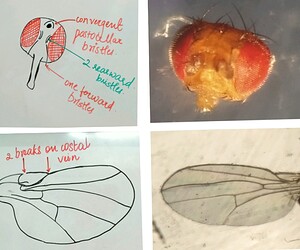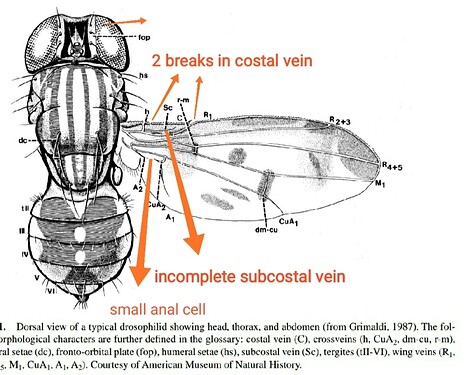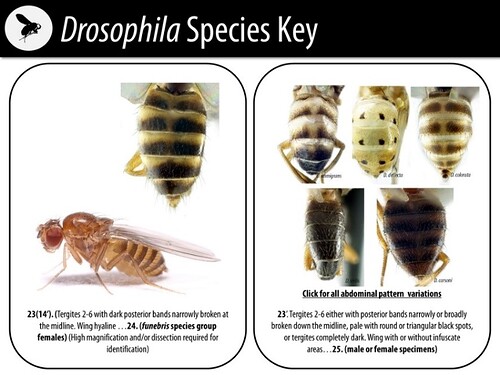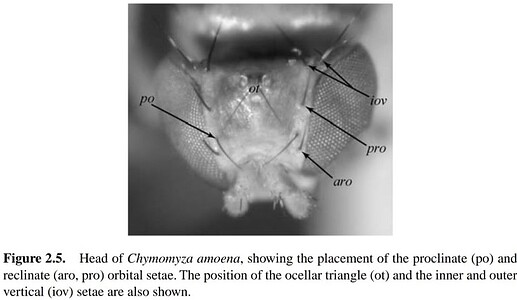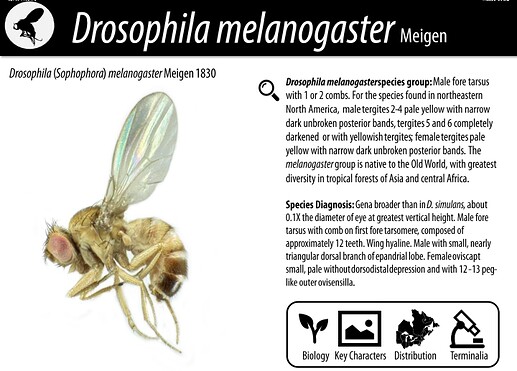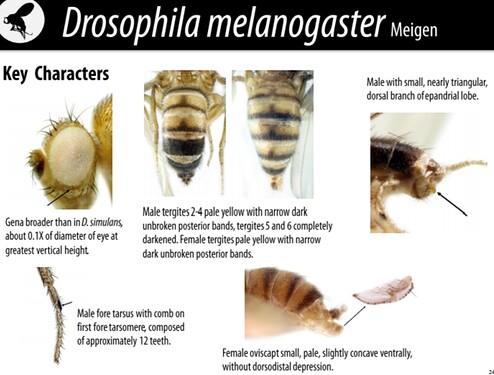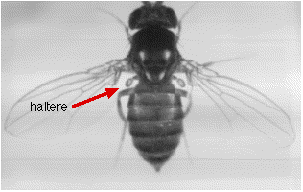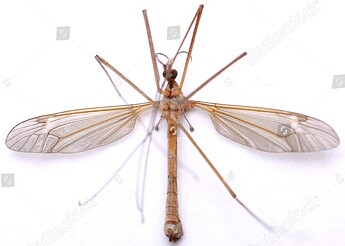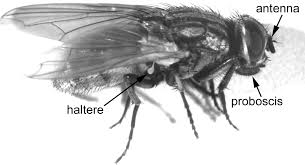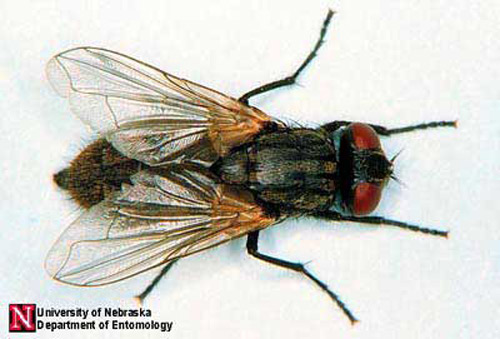There is a large number of living organisms found on the earth.
All these organisms show variations in their shape, size, structure, habit, habitat, nutrition, etc.
It is difficult to remember the characteristics of all the organisms without their proper arrangement.
The classification helps to explain unity in diversity of the organisms.
It gives specific and scientific names to the organisms which are accepted universally.
It reveals the relationships among various groups of organisms. The classification places an organism amongst those which have common characteristics.
Classification and Identification is therefore an important factor in FRUIT FLIES too!! And this is how we go about…
IDENTIFICATION OF FRUIT FLIES
Preparation for identification of fruit flies.
What are the requirements???
3 (or 4) dead flies, a microscope, phone camera
• No microscope, then,
You can use your mobile camera for looking into whatever characteristics you would be looking for in our fly.
How can you get these dead fruit flies?
In labs we use anesthetizing chemical like ethanol, chloroform.
- Take an empty falcon tube
- Keep a cotton plug ready of which its end is dipped in either ethanol or chloroform.
- Take out some flies from the fruit fly culture bottle into this empty falcon tube
- Close this falcon tube with cotton plug which was kept ready earlier.
- Within 15 mins you will get the flies dead in the falcon tube.
What if we are at home???
- Take an empty plastic container or a bottle
- Take out some flies from the fruit fly culture bottle into this empty plastic bottle or container
- Close the culture bottle
- And close the plastic container or the bottle with its lid or cap.
- The flies are trapped inside this plastic bottle.
- It takes a day for these flies to die inside this empty plastic bottle because of no air inside
This is how we get dead fruit flies!!!
Now we have the dead fruit flies ready, microscope ready (if at lab), phone camera ready!!!
Let’s move further in our identification.
This is where taxonomy comes into picture:
Taxonomy is the classification of something; in our case it’s the organisms.
The classification or the different levels in taxonomy are Kingdom, Phylum, Class, Order, Family, Genus, Species.
We are going to classify our fruit flies on the basis of these levels in the taxonomy.
KINGDOM: Animalia (other kingdom is Plantae)
PHYLUM: Arthropoda (other phyla: Porifera, Cnidaria, Annelida, Mollusca, Chordata etc.)
CLASS: Insecta (other classes: trilobite, chelicerata, crustacean, myriapoda)
ORDER: Diptera (other orders: Blattodea, Coleoptera, Collembola, Dermaptera)
FAMILY: Drosophilidae (other families: Ephydridae, Camillidae, Curtonotidae)
GENUS: Drosophila (other genus: Chymomyza, Cladochaeta, Liodrosophila)
SPECIES: Drosophila melanogaster (other species: Drosophila hydei, Drosophila melanoloma, Drosophila melanoptera)
PHYLUM: Arthropoda
- An exoskeleton
- A segmented body
- Paired jointed appendages. (antennae, 3 pairs of legs)
- The distinguishing feature of arthropods is the presence of a jointed skeletal covering composed of chitin (a complex sugar). The body is usually segmented, and the segments bear paired, jointed appendages, from which the name arthropod (“jointed feet”) is derived.
CLASS: Insecta
- Hexapod invertebrates.
- Chitinous exoskeleton.
- Three-part body (head, thorax and abdomen).
- Three pairs of jointed legs.
- Compound eyes.
- One pair of antennae.
Insects are distinguished from other arthropods by their body, which is divided into three major regions:
a) The head, which bears the mouthparts, eyes, and a pair of antennae.
b) The three-segmented thorax, which usually has three pairs of legs (hence “Hexapoda”) in adults and usually one or two pairs of wings.
c) The many-segmented abdomen, which contains the digestive, excretory, and reproductive organs.

ORDER: Diptera
- di- “two”, and pteron “wing”
- a single pair of wings
- Hindwings turn to halteres (pair of small club-shaped organs on the body- used for body rotations during flight)
- Dipteran, (order Diptera), any member of an order of insects containing the two-winged
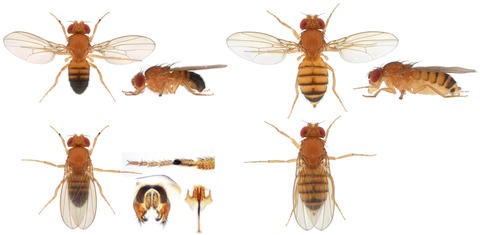
FAMILY: Drosophilidae
The diagnostic characteristics for Drosophilidae include
- The presence of an incomplete subcostal vein.
- Two breaks in the costal vein.
- A small anal cell in the wing.
- Convergent postocellar bristles.
- Three frontal bristles on each side of the head (One directed forward and the other two directed rearward).
- Body length: 3-4 mm
• Body color: golden or brownish to blackish colored body
• Head ID features:
a) Arista plumose (antennae branched).
b) Two post vertical bristles (located on back of head) converge.
c) Oral vibrissae (pair of large bristles above mouth) well developed.

GENUS: Drosophila
Features helpful in identifying species of this genus
- Mesonotum, dorsal view, showing number of rows of hairs, orientation and presence of various bristles and colors patterns.
- Banding patterns on the dorsal abdomen: whether the bands are interrupted along the mid-line, and whether there are any obvious spotting patterns.
- Foreleg to see sex combs.
- Wing coloration: clear versus clouding at cross veins or tips.
Characteristics of genus Drosophila
https://cjai.biologicalsurvey.ca/mmg_31/mmg_31.pdf
- Small yellow to brown flies.
- Body 2-6mm long.
- Facial carina well developed (including lower portion of face).
- Arista with 2 or more ventral branches.
- Postocellar setae well developed.
- Proclinate orbital seta stronger than and arising anterior to reclinate orbital seta.
- Mesonotum and pleuron unicolorous, or with stripes or spots.
- Proepisternal setae absent.
- 3 katepisternal setae.
- Achrostichal setulae in 6-8 rows.
- 2 pairs of dorsocentral setae.
- Prescutellar acrostichal setae absent.
- Wing uniformly hyaline or with infuscate areas.
- Abdomen unicoulourous or with transverse bands or spots.
SPECIES: Drosophila melanogaster
https://www.sciencedirect.com/topics/neuroscience/drosophila-melanogaster
https://cjai.biologicalsurvey.ca/mmg_31/mmg_31.pdf
- Yellowish species.
- Male fore tarsus with 1-2 combs.
- Male tergites 2-4 pale yellow with narrow dark unbroken posterior bands, tergites 5 and 6 completely.
- Female tergites 2-6 pale yellow with narrow dark unbroken posterior bands.
For making whatever I’ve written here reliable, I have given references too for cross checking.
Please go through all the references.
I hope this blog is helpful for everyone.

